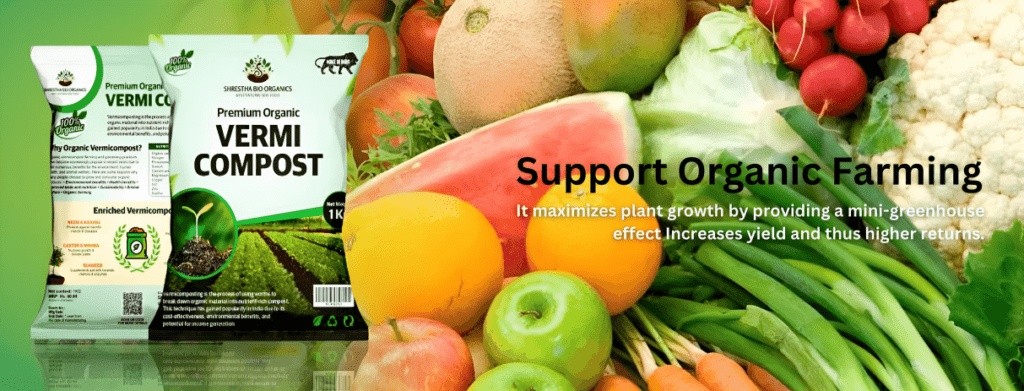Introduction
Sustainable and organic agricultural methods have become very popular in the modern world. The demand for organic and environmentally friendly farming practices has grown as people’s awareness of the environment and the quality of their food has increased. Vermiculture, the activity of cultivating vermicompost, is one such method that has attracted a lot of interest. This in-depth tutorial will cover vermiculture’s definition, methods for producing vermicompost, and benefits for sustainable agriculture. Additionally, we’ll introduce you to Shrestha Bio Organics, a reputable supplier of premium vermicompost for your agricultural requirements.
Summary Of Blog
- Understanding Vermicompost
- 1.1 What is Vermicompost?
- 1.2 The Science Behind Vermicomposting
- 1.3 Why Vermicompost is a Game Changer for Agriculture
- Setting Up Your Vermicomposting System
- 2.1 Choosing the Right Worm Species
- 2.2 Selecting a Suitable Container
- 2.3 Preparing the Bedding Material
- 2.4 Creating the Ideal Environment for Worms
- Feeding Your Worms
- 3.1 Ideal Food for Vermicomposting
- 3.2 Feeding Guidelines
- 3.3 Maintaining a Balanced Diet for Worms
- Harvesting Vermicompost
- 4.1 Signs That Vermicompost is Ready
- 4.2 Methods for Harvesting
- 4.3 Storing Vermicompost
- Benefits of Vermicompost for Agriculture
- 5.1 Improved Soil Structure
- 5.2 Enhanced Nutrient Availability
- 5.3 Pest and Disease Suppression
- 5.4 Sustainable Agriculture
- Promoting Shrestha Bio Organics for Vermicompost
- 6.1 The Shrestha Bio Organics Difference
- 6.2 Why Choose Shrestha Bio Organics?
- 6.3 Testimonials from Satisfied Customers
- Conclusion: Nurturing the Earth and Your Crops with Vermicompost
Understanding Vermicompost
1.1 What is Vermicompost?
Vermicompost, often referred to as “black gold,” is a nutrient-rich organic fertilizer produced through the process of vermicomposting. It’s created by using earthworms to decompose organic materials, such as kitchen scraps, garden waste, and other biodegradable matter. The end result is a dark, crumbly, and odorless compost that’s teeming with beneficial microorganisms and essential nutrients.

1.2 The Science Behind Vermicomposting
Vermicomposting is essentially nature’s way of recycling organic materials. Earthworms, typically species like Eisenia fetida and Lumbricus rubellus, play a vital role in this process. They ingest organic matter, break it down within their digestive system, and then excrete it as vermicompost. The enzymes and microorganisms present in the earthworms’ gut further enhance the composting process.
1.3 Why Vermicompost is a Game Changer for Agriculture
Vermicompost is a revolutionary addition to modern agriculture for several reasons:
- Enriched Nutrient Content: Vermicompost is a nutrient powerhouse, rich in essential elements such as nitrogen, phosphorus, potassium, calcium, magnesium, and various micronutrients. These nutrients are present in a form that is easily accessible to plants.
- Improved Soil Structure: The organic matter and microorganisms in vermicompost help improve soil structure by enhancing aeration and water retention. This, in turn, leads to healthier plant root systems.
- Enhanced Microbial Activity: Vermicompost is teeming with beneficial microorganisms that support plant growth and protect against harmful pathogens.
- Pest and Disease Suppression: The compounds produced during vermicomposting have been shown to suppress plant diseases and pests, reducing the need for chemical interventions.
- Sustainable Agriculture: Vermicomposting helps reduce the reliance on chemical fertilizers and promotes sustainable farming practices by recycling organic waste into valuable resources.
Setting Up Your Vermicomposting System
2.1 Choosing the Right Worm Species
The choice of worm species is crucial for a successful vermicomposting system. The two most commonly used species for vermicomposting are Eisenia fetida (red wigglers) and Lumbricus rubellus. These worms are highly efficient at breaking down organic matter and reproducing under suitable conditions.
2.2 Selecting a Suitable Container
Vermicomposting can be done in various containers, ranging from simple wooden boxes to specialized worm bins. The key is to choose a container that provides adequate ventilation, insulation, and moisture control. Shrestha Bio Organics offers a range of worm bins that are designed to make the process of vermicomposting easy and efficient.
2.3 Preparing the Bedding Material
The bedding material serves as the worms’ living environment and a source of nutrition. Common bedding materials include shredded newspaper, cardboard, coconut coir, or a mixture of these materials. Ensure that the bedding is moist, but not waterlogged, to create an ideal habitat for the worms.
2.4 Creating the Ideal Environment for Worms
Maintaining the right environment for your worms is essential. Here are some key factors to consider:
- Temperature: Worms thrive in temperatures between 55°F and 77°F (13°C to 25°C). Keep your vermicomposting system within this range.
- Moisture: Ensure that the bedding material remains consistently moist, similar to a wrung-out sponge. Regularly monitor the moisture level to prevent drying out or waterlogging.
- Ventilation: Proper aeration is crucial to avoid foul odors and promote the growth of beneficial microorganisms. Ventilation holes in your worm bin will help maintain the necessary airflow.
Feeding Your Worms
3.1 Ideal Food for Vermicomposting
Worms are not picky eaters, but some foods are more suitable than others for vermicomposting. Ideal foods include:
- Fruit and vegetable scraps
- Coffee grounds and tea bags
- Crushed eggshells (a valuable source of calcium)
- Small amounts of paper products
- Garden waste (excluding diseased plants)
Avoid feeding your worms meat, dairy, oily foods, and citrus fruits, as these can attract pests and create imbalances in the bin.
3.2 Feeding Guidelines
Feed your worms small, manageable portions of food regularly. Start by adding a thin layer of kitchen scraps or other organic materials on top of the bedding. As the worms process the initial layer, you can gradually add more. Avoid overfeeding, as this can lead to excess moisture and odors in the bin.
3.3 Maintaining a Balanced Diet for Worms
Just like humans, worms need a balanced diet. To ensure their health and productivity, vary the types of food you provide. A mix of green (nitrogen-rich) and brown (carbon-rich) materials is recommended. This helps maintain the carbon-to-nitrogen (C:N) ratio and ensures a balanced diet for your worms.
4. Harvesting Vermicompost
Signs That Vermicompost is Ready
Vermicompost is ready for harvesting when it appears dark, crumbly, and resembles rich, fertile soil. You’ll notice that the original bedding materials have been transformed, and the compost has a pleasant earthy smell. It usually takes a few months to a year for the compost to be ready, depending on factors like temperature and the number of worms.
4.2 Methods for Harvesting
There are various methods for harvesting vermicompost:
- Light Sorting: Place fresh food on one side of the bin. The worms will migrate towards the new food source, allowing you to scoop out the vermicompost from the other side.
- Horizontal Migration: Create separate trays or sections in your worm bin. As the worms finish processing one tray, they will migrate upwards to the fresh tray, leaving the lower tray full of vermicompost.
- Screening: Use a mesh screen to sift out the vermicompost, leaving behind any remaining worms and larger, unprocessed materials.
4.3 Storing Vermicompost
Once harvested, store your vermicompost in a cool, dry place, away from direct sunlight. Properly stored vermicompost can be used as a soil conditioner, fertilizer, or plant growth booster whenever you need it.
Benefits of Vermicompost for Agriculture
5.1 Improved Soil Structure
One of the most significant advantages of using vermicompost in agriculture is its ability to improve soil structure. It enhances aeration and water-holding capacity, which results in better root development and overall plant health. This crumbly texture allows for root penetration and oxygen exchange, vital for robust plant growth.
5.2 Enhanced Nutrient Availability
Vermicompost is a treasure trove of essential plant nutrients. Unlike synthetic fertilizers, the nutrients in vermicompost are released slowly and in a form that plants can readily absorb. This gradual nutrient release promotes sustained plant growth, reduces nutrient leaching, and prevents soil degradation.
5.3 Pest and Disease Suppression
Vermicompost contains beneficial microorganisms that outcompete harmful pathogens in the soil. This natural suppression of pests and diseases reduces the need for chemical pesticides and herbicides, making your farming practices more sustainable and environmentally friendly.
5.4 Sustainable Agriculture
In an era of increasing environmental awareness, sustainability is a key goal in agriculture. Vermicomposting aligns perfectly with this objective. By recycling organic waste into valuable resources, it not only reduces the environmental burden but also promotes long-term soil health, ensuring the land’s productivity for generations to come.
Shrestha Bio Organics for Vermicompost
6.1 The Shrestha Bio Organics
Shrestha Bio Organics is your trusted partner in vermicomposting and sustainable agriculture. Our commitment to quality, innovation, and eco-friendliness sets us apart in the industry. When you choose Shrestha Bio Organics for your vermicompost needs, you benefit from:
- High-Quality Vermicompost: Our vermicompost is carefully produced to provide the best nutrients for your crops. We maintain strict quality control standards to ensure the finest product.
- Eco-Friendly Approach: We believe in responsible and sustainable practices. Our vermicomposting processes are designed to minimize environmental impact while maximizing results.
- Expertise and Support: Our team of experts is always ready to assist you in setting up and maintaining your vermicomposting system. We’re committed to your success.
6.2 Why Choose Shrestha Bio Organics?
When you choose Shrestha Bio Organics for your vermicompost needs, you’re making a wise decision for your crops, your soil, and the environment. We offer a range of vermicompost products suitable for all types of farming, from backyard gardens to large-scale agricultural operations. Our commitment to quality, sustainability, and customer satisfaction is unmatched.
6.3 Testimonials from Satisfied Customers
But don’t just take our word for it; here are some testimonials from our satisfied customers:
- “Shrestha Bio Organics’ vermicompost has transformed my garden. My vegetables are healthier, and my soil has never looked better. I wouldn’t use any other product.” – Sarah L., Home Gardener
- “As a farmer, I rely on quality products for my livelihood. Shrestha Bio Organics delivers exceptional vermicompost consistently. My yields have increased, and my soil quality is outstanding.” – John M., Farmer
- “I appreciate the commitment to sustainability and the environment that Shrestha Bio Organics represents. Their vermicompost is a testament to responsible farming practices.” – Lisa K., Environmental Advocate
Conclusion: Nurturing the Earth and Your Crops with Vermicompost
Vermicomposting is a sustainable and environmentally friendly approach to farming that has gained significant popularity for its numerous benefits. By understanding the process, setting up an efficient system, and using high-quality vermicompost like that from Shrestha Bio Organics, you can transform your agricultural practices and reap the rewards of healthier crops and soil.
Make the switch to vermicomposting, and you’ll not only promote sustainable agriculture but also contribute to a healthier planet. Choose Shrestha Bio Organics for your vermicompost needs, and together, we can nurture the earth and your crops for a brighter, more sustainable future.


